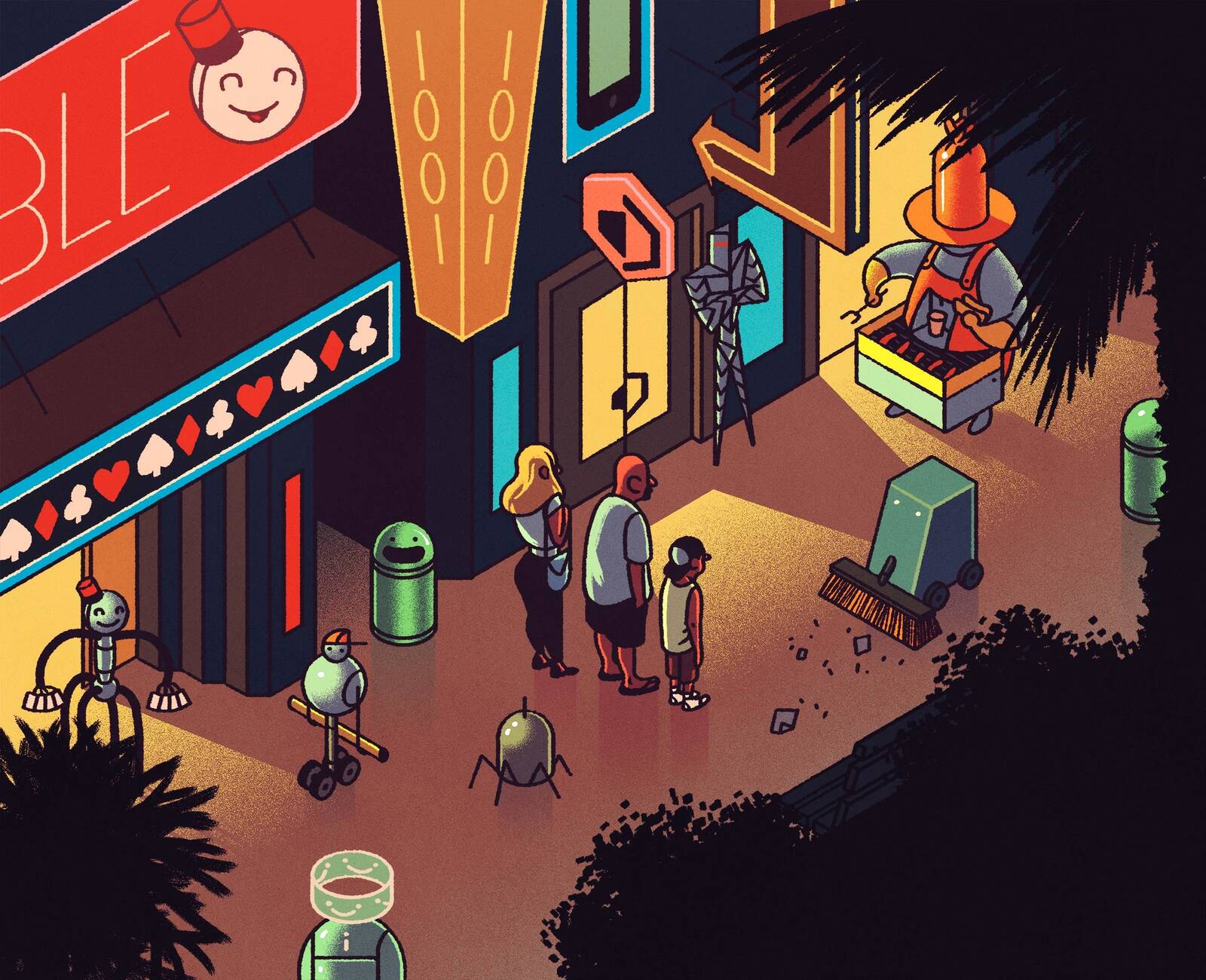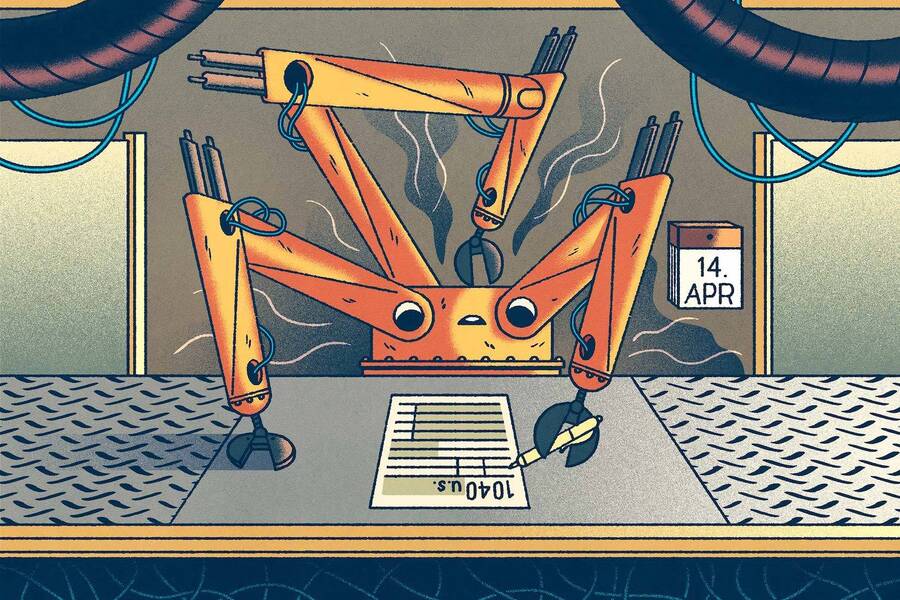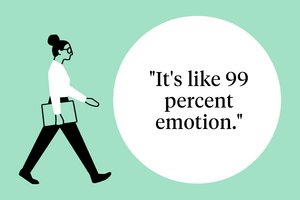Careers Apr 10, 2018
How Will Automation Affect Different U.S. Cities?
Jobs in small cities will likely be hit hardest. Check how your community and profession will fare.

Michael Meier
Casino dealers and fishermen are both likely to be replaced by machines in coming years. So which city will lose more of its human workforce—Las Vegas, the country’s gambling capital, or Boston, a major fishing hub?
People tend to assume that automation will affect every locale in the same, homogeneous way, says Hyejin Youn, an assistant professor of management and organization at Kellogg. “They have never thought of how this is unequally distributed across cities, across regions in the U.S.”
It is a high-stakes question. The knowledge that certain places will lose more jobs could allow workers and industries to better prepare for the change and could help city leaders ensure their local economies are poised to rebound.
In new research, Youn and colleagues seek to understand how machines will disrupt the economies of individual cities. By carefully analyzing the workforces of American metropolitan areas, the team calculated what portion of jobs in each area is likely to be automated in coming decades.
They found that, in general, small cities will have higher portions of their workforce replaced by machines than large cities. The reason: While cities of all sizes have many easily automated jobs (like card dealers, fisherman, cashiers, and accountants), large cities like Boston also have larger shares of managerial and knowledge professions (like lawyers, scientists, and software developers). Since these jobs require knowledge and skills that cannot easily be taught to a machine, they will offset the total impact of automation. In smaller cities, fewer of those offsetting jobs exist.
Based on this finding, Youn says small cities could see an exodus of workers, as well as exacerbated income inequality, since robots are likely to hollow out the middle class there. And large cities are not entirely immune. Las Vegas, for example, has two million people in its metropolitan area, but its economy relies heavily on an industry whose jobs are likely to be automated.
“If I’m the policymaker in Las Vegas, I have to think about how to reshape my city’s industry to prepare,” she says.
Specialization and Automation
The larger a city’s population, the more specialized its jobs tend to be. To illustrate why, Youn thinks about the restaurant industry.
In a small town, there are likely a few small restaurants run by a few people who do many things—cook, clean, manage the books, etc. “Some of these tasks are easily enough defined to soon be automatable,” Youn says.
By contrast, in a larger city there will likely be some much larger restaurants that require more specialized knowledge and skills—perhaps a marketing team, or a lawyer who specializes in the restaurant industry—that cannot be easily automated.
It was not clear to economists whether a more specialized workforce would lead to more or less automation.
It was not clear to economists, however, whether a more specialized workforce would lead to more or less automation.
In some contexts, specialization allows for a greater division of labor, breaking down the production process into distinct, repetitive jobs like you might see on an assembly line. “That makes the person’s task really, really easy to be replaced,” Youn says.
But specialization can also have the opposite effect. Although scientists and managers have a highly specific set of skills, robots would struggle to do their jobs. “The kind of knowledge they have is specialized, but it’s also at the frontier, so a machine cannot replace it yet,” Youn says.
To quantify the total impact of automation on a given city, Youn teamed up with Massachusetts Institute of Technology researchers Morgan Frank, Lijun Sun, Manuel Cebrian, and Iyad Rahwan.
The researchers needed to figure out exactly what portion of a city’s jobs boiled down to routine tasks versus specialized expertise. They used a dataset developed by researchers at Oxford University that estimates the likelihood of a particular job being automated based on the skills it requires. By combining that information with U.S. Bureau of Labor Statistics data on the composition of each city’s workforce, they were able to predict how many workers would be displaced in 380 metropolitan areas across the United States.
Why Automation Will Hit Small Cities Harder
The research resulted in an “impact score” for each city, which translates into the average likelihood that a job there will be impacted by automation.
The results showed that Boston, with a 54 percent impact score, is among the least susceptible cities to be changed by automation. That likely has to do with the multitude of hospitals and research universities, says Youn.
“A lot of the occupations are associated with medicine, startups, and education—things that are not really automatable yet,” she says.
The same is true in the two large cities that top the list of those most impervious to robots: Washington, DC, and San Jose, California, in the heart of Silicon Valley.
By contrast, smaller cities tend to have larger shares of cashiers, retail salespeople, receptionists, and food-service workers—the types of jobs that can be more easily automated. Las Vegas, a metro area less than half the size of Boston, could see 68 percent of its jobs automated. Worse still are the predictions for tiny cities like Mayagüez, Puerto Rico, where 73 percent of the workforce is likely to be automated.
“You don’t normally see physicists in really small towns,” Youn says. “You don’t see CEOs in really small towns.”
But even CEOs and physicists are not entirely in the clear. Youn’s estimates are based on the skills that today’s machine-learning experts predict robots can take over. As artificial intelligence and machine learning empower machines to move beyond simple, repetitive tasks, more and more jobs will be up for grabs.
“I don’t know how long it will take,” Youn says, “but if they become really generalized machines, it will be a different story.”
What’s a Small City to Do?
Youn expects the more intense job loss will push people to leave smaller cities in search of work. “And where do you find a new job? A larger city,” she says. “So urbanization will continue to happen, aggravated by this automation hit.”
Youn also notes that, besides white-collar workers, only one other class of jobs will likely avoid automation: extremely low-wage positions, such as janitors. “There’s little incentive to automate, because automation requires capital,” and that labor is already very cheap, Youn explains.
Therefore, formerly middle-class workers whose jobs have been automated will be pushed to find work at the far extremes of the wage distribution, since those kinds of jobs—CEOs on one end and janitors on the other—will be the only human positions left. And because the easy-to-automate mid-range jobs are more prevalent in smaller cities, inequality will rise faster there.
Worrying as these consequences may be for small cities, Youn thinks there is a silver lining: policymakers now have a better, more nuanced idea of what to expect.
Had the researchers found that automation was completely random, with no relation to city size, there would be no way to predict how a particular city might fare.
“But there is a systematic differentiation,” Youn says. “And since it’s systematic, we can prepare for it.” That is, small cities might preemptively set up job-retraining programs, or create incentives to attract new, high-tech industries where workers cannot easily be replaced by machines, as opposed to focusing on creating jobs that could be automated in the near future.
Her findings have left Youn wanting to take an even more detailed look at how automation impacts a company or a job. For example, while email and digital scheduling have replaced some workers, she notes that they have also spurred productivity and innovation for remaining workers, which may improve a company’s bottom line. Disentangling the contrasting roles that technology plays could help predict which industries machines will disrupt next.
“Every task will be some form of collaboration with a machine,” she says, as machines get smarter and can assist with increasingly specialized work. “The question is: How will this either help or destroy jobs?”



